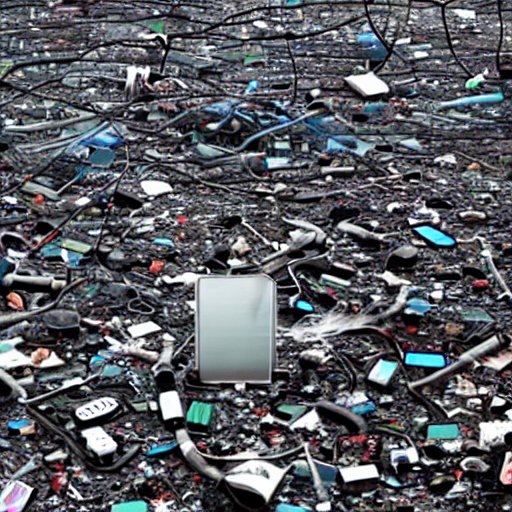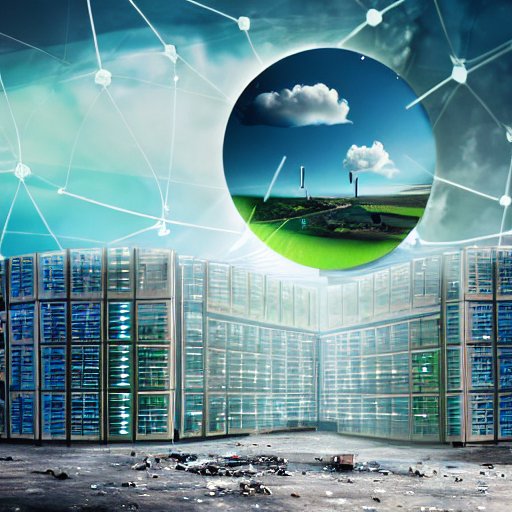Yesterday, March 18, was the Digital Cleanup Day, in other words: World Digital Cleanup Day. Indeed, it may seem surprising to you, but, just like our homes, our food and our means of transport, the internet pollutes, emits CO2 and consumes an increasingly large part of energy. The digital ecological impact is thus increasingly greater through hardware (equipment) and software (use). Thus, we can reduce our digital CO2 impact by remaining reasonable on the renewal of our digital devices and by doing a good spring cleaning from time to time. This by deleting our useless data in order to lighten the weight of CO2 that they generate daily. Let's see all this in more detail...
But by the way, how does the Internet work?
When we use a computer connected to the internet, we can easily have the impression that the connection arrives "by magic" to our devices. This is all the more true since the generalization of the Wifi connection which has brought with it the disappearance of a majority of the RJ-45 cables which make it possible to connect a computer to the Internet by wire. But then, what happens on the other side of an internet box?
First of all, the box is connected to our operator's network via the wall socket. This connection is made using cables that run along the building to reach the outside where they continue their way (most often under the ground), to the infrastructures of our internet providers. Today, we mainly find fiber optic cables that allow data to pass faster than the ADSL technology (via old copper telephone wires) that they have replaced.
Then, the different operators are linked together. Either by terrestrial cables when they are located on the same continent, or by means of submarine cables which make it possible to connect the various continents between them. The network formed by all these cables forms what is called “the web”, in other words: internet. When we send data from one computer to another, it travels along all these cables at the speed of light (or almost) until it reaches its destination, sometimes over thousands of km and this in a few micro seconds. only. On their way, they will pass through infrastructures. In the event of backup in the cloud (online), they will also be stored in data centers: gigantic computers grouped together in computer parks.
And this is where things get complicated.
All these infrastructures are connected to the electricity grid and consume electrical energy. This consumption still too often comes from non-renewable energy sources that generate large quantities of CO2. Although Google, for example, tries to place its Datacenters in countries or regions where the CO2 balance is more interesting. Google is also investing in solar power plants. In addition, data centers give off a lot of heat and therefore need to be constantly cooled. So of course, the big companies in the digital sector must act, this is explained in detail in the video below.
But at our level, we can also help limit the pollution linked to our use of digital technology. Not by stopping using the internet, but by establishing in our habits, a series of good practices limiting the amount of data we generate, and especially that we store (often unnecessarily).
Let's reduce our personal digital pollution together:
By reducing the amount of stored data
With the increase in the storage capacities of our devices, and the democratization of online storage solutions, we have lost the habit of erasing data that we no longer need. Very often: our mailboxes are overflowing, our smartphones are saturated under the weight of our received text messages and sometimes missed photos... Our computers look like a battlefield in which we struggle to find this "important file" that we have saved alongside other cumbersome useless documents. If you recognize yourself in this observation, then it's time to clean up all that...
- For our mailboxes we can :
- Delete all messages which we no longer need
- Take advantage of it for us unsubscribe from newsletters that we never read (a link to opt out of sending them is often present at the bottom of the newsletter in small print)
- Create categories for the emails that we wish to keep, the cleaning of our mailbox will be greatly facilitated!
- For our phones it is possible :
- Delete all text messages that very often we will never read again...
- Here again it is possible to unsubscribe from certain message chains (often by sending "stop" to a number provided to us for this purpose)
- De sort our photographs ! Deleting duplicates, blurry photos, and mistakenly taken screenshots often frees up a lot of space.
- It can also be an opportunity to then migrate the photos that you want to keep on an external physical medium (hard disk, memory card) in order to prevent them from saturating the internal memory of the phone, which can go so far as to make it unusable in the event of excessive overload!
- De uninstall apps that we don't use or no longer use. Since a fairly recent Android update, permissions are removed after a few months of non-use, allowing you to target those unused apps easily. Please note that some default applications cannot be deleted.
- to use phone cleaning tool to clear caches and delete unnecessary app data.
- Try to fix your phone in the event of a fall. It is often very economically attractive to repair your phone. Integral protective shells and screen overprotection films are now often quite effective.
- And especially of don't change phone with each new moderator, the only goal is often to make your friends drool: why? Unlike the 2000-2010 era when their technology was evolving very quickly (the 1st iPhone was released in early 2007), it is currently possible to keep a smartphone for more than 10 years despite planned obsolescence.
- For our computers, you can improve things:
- En deleting documents which we no longer need.
- En organizing files to store our files (which will make daily use of the computer more pleasant). Attention, it is advisable to place these different folders in 'Documents', 'Images', 'Videos' etc according to their category, rather than directly on the desktop where they can be erased more easily.
- Many computer optimization software can help keep your machine performing for years. Most of these software are free or have a free version. You will find a fairly complete list here.
- Same remark as for smartphones concerning the material: you can today keep a computer for more than 10 years, unlike the computers of the 1990s where it had to be renewed every 2 years. This even for PC Gamers, provided you bought at the time.
- Finally in general we can:
- Remember to regularly empty the baskets of our electronic devices
- Take the reflex to delete our data regularly: ideally daily, or at least once a month
- Do not renew the material too often
By not replacing too often and recycling our used electronic devices…

The average lifespan of a smartphone in France is 18 months, in other words, on average, the French buy a smartphone every 18 months for reasons of breakage, loss or worse, consumerist fashion! This has an impact upstream (manufacturing) and downstream (recycling). However, it is possible to keep a smartphone much longer than that, provided you have purchased a quality model, probably a little more expensive to buy but which will be largely profitable over the years. In 2023, it is quite possible to still use smartphones and digital equipment such as PCs of the 2014 / 2015 or even older generation, provided that you have not purchased the first prices of the time. This without the need to buy high-end, overpriced.
In our landfills far too much waste could have been sorted! This is of course the case with many electronic devices. However, these can be recovered in various places:
- If you buy a new electronic device, the retailer is generally obliged to take back the old one.
- Waste collection centers have specific skips for this type of waste
- Finally, small electronic devices (telephones in particular) can be dropped off at collection points in many supermarkets.
In the same way, batteries, and remember the light bulbs and neon lights, are also recovered in many shopping centers. On the other hand, it is important not to put them in the yellow collection bags, they can damage the sorting machines or cause fires!
By promoting the purchase of refurbished equipment
What if your new laptop was on the now well-known Back Market ? In addition to costing you between 20 and 70% less than a new device, your new electronic companion will also cost the environment much less! Just like a device that you would have bought new, it will also be guaranteed: for a period of one year. What make you want to take the plunge, don't you think?
If you don't want to buy second-hand equipment on the internet, Electro-Depot also offers a fairly wide range of very good quality refurbished smartphones under the French brand Reborn. We bought one recently, it was new and less than 50% of the new price.
Of course, only buy what you really need! The opportunity to remember that it is sometimes also possible to have a defective device repaired (at a repairer, or if you have one near you, in a recycling center that organizes repair workshops). If you don't have any of this in your city, a tutorial that can sometimes easily solve your problem can be found simply on Youtube?
The consumer dictates the laws of the market
This is a reality that is often forgotten: buying is voting.
Through our personal choices, we can influence digital players. So every year Greenpeace assigns a score to the major players in the sector according to the efforts they make to turn to cleaner energies to reduce their impact on the planet. Something to ponder on our real need to use the most poorly rated services… Why not turn instead to the alternatives offered by those who make the effort to improve their ecological performance?
Good to know
In France, since August 17, 2015, planned obsolescence (a practice aimed at deliberately reducing the lifespan of electronic devices), is recognized as a crime and punishable by law (still have to succeed in proving it…)!
An essential measure when you know that in France:
- Digital represents 2.5% of the carbon footprint alone
- 10% of annual electricity consumption is attributable to it
- 20 million tons of waste per year comes from digital devices (i.e. 299 kg per inhabitant)
These figures are provided by a study of the ademe.
They demonstrate the urgency of acting on this issue. Suggestions or questions? Use the forum electronics and computer

